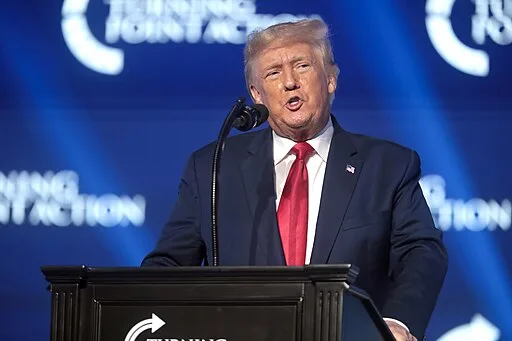Former president Donald Trump’s plane was diverted to Billings due to mechanical issues ahead of a Montana rally, while Vice President Kamala Harris and Governor Tim Walz energized supporters in Arizona
Former President Donald Trump’s campaign rally in Montana faced an unexpected hiccup on August 9, 2024, when his plane experienced mechanical problems. Scheduled to land in Bozeman, Trump’s flight was diverted to Billings Logan International Airport. With a rally planned for the evening in Bozeman, Trump quickly boarded another plane to reach his destination and continue his campaign efforts.
Trump’s Montana visit was aimed at rallying support for Tim Sheehy, the GOP Senate candidate challenging Democratic incumbent Jon Tester. Despite Montana’s Republican stronghold, Trump’s appearance was designed to provide a significant boost to Sheehy’s bid.
Embed from Getty ImagesMeanwhile, Vice President Kamala Harris and Minnesota Governor Tim Walz focused their campaign efforts on Arizona, a pivotal battleground state. Their campaign stops in Arizona underscored the state’s importance in the 2024 election. In Glendale, Harris addressed a large crowd, criticizing former President Trump’s approach to immigration reform. She argued that Trump’s promises on border security had not translated into effective policies, highlighting the need for comprehensive reform.
During the rally, Harris also faced interruptions from protestors chanting about Gaza. In response, she reaffirmed her commitment to pursuing a cease-fire deal and working to secure the release of hostages, emphasizing her and President Biden’s ongoing efforts in this area.
Governor Walz used his speech to counter Trump’s influence, urging supporters to defeat Trump at the polls rather than through chants of “lock him up.” Walz joked about the Arizona heat, likening himself to a snowman melting in the sweltering temperatures, and played off the large crowd’s enthusiasm, which numbered over 15,000.
Harris and Walz’s visit to Arizona also included a stop at a local campaign office, where they interacted with volunteers and engaged with Arizona content creators and influencers. The rally saw extensive participation, with the campaign providing water and fans to help attendees cope with the 105-degree heat.
The contrasting events in Montana and Arizona highlighted the strategic focus of both presidential campaigns. While Trump’s logistical challenges were a minor setback, Harris and Walz’s engagement with key issues and voters in Arizona demonstrated their campaign’s dynamic approach.
Analysis:
Political: Trump’s plane diversion underscores the unpredictable nature of high-stakes political campaigns. While the mechanical issue posed a logistical challenge, it did not significantly disrupt Trump’s campaign strategy. The event highlights the importance of robust contingency plans in managing presidential campaign logistics. On the other hand, Harris and Walz’s concentrated efforts in Arizona reflect the strategic value Democrats place on battleground states. Their campaign’s focus on immigration reform and voter engagement demonstrates an attempt to consolidate support in a crucial swing state.
Social: The events in Montana and Arizona reflect broader societal dynamics. Trump’s rally in a Republican stronghold and Harris’s address on immigration reform illustrate ongoing political and social divides. Harris’s handling of protests about Gaza at her rally reveals how political figures navigate complex and sensitive international issues while maintaining domestic support. This interaction underscores the influence of global events on local political campaigns and public sentiment.
Racial: The protests at Harris’s rally, which included chants about Gaza, highlight ongoing racial and ethnic tensions that impact political discourse. These interruptions reflect a broader societal concern about U.S. involvement in international conflicts and the implications for various communities. The reaction from Harris indicates an awareness of these racial and international issues, revealing how candidates address and balance diverse voter concerns.
Gender: Vice President Kamala Harris’s role as the first female vice-presidential candidate from a major party brings gender dynamics to the forefront of the campaign. Her response to protestors and her engagement with the crowd showcase the unique challenges and opportunities faced by women in high-profile political roles. Harris’s ability to manage interruptions and maintain focus on key issues exemplifies the resilience and adaptability required of female candidates in contemporary politics.
Economic: The logistical challenges faced by Trump and the extensive resources utilized by Harris and Walz for their Arizona campaign reflect the significant economic aspects of running a national campaign. The diversion of Trump’s plane and the provision of amenities for Harris’s rally attendees illustrate the financial investments required for effective campaigning. These economic considerations are crucial in shaping campaign strategies and addressing voter needs.
